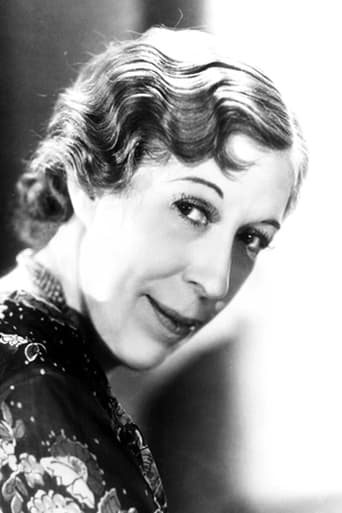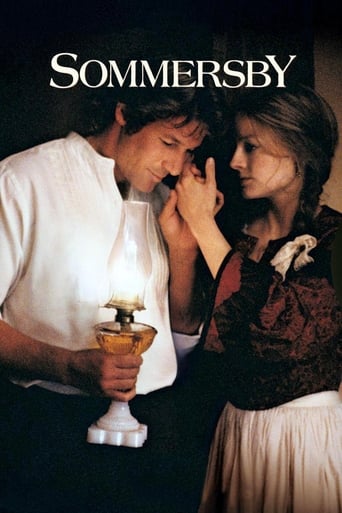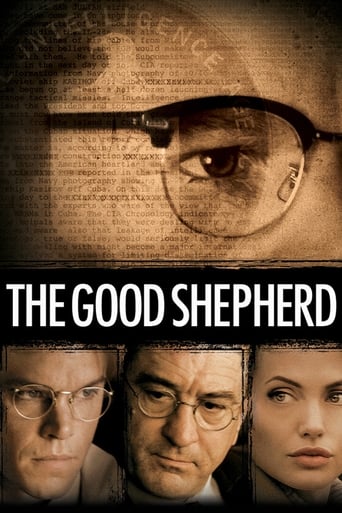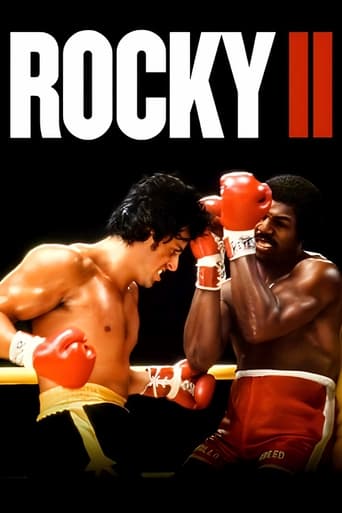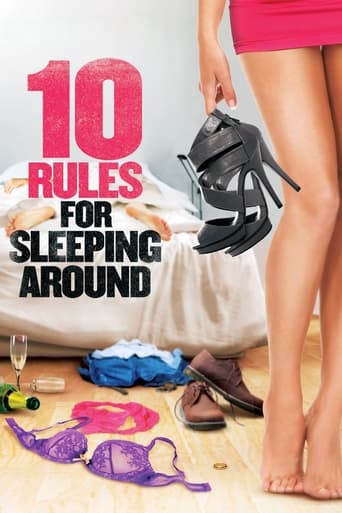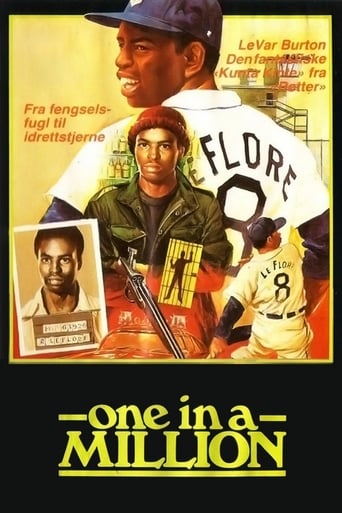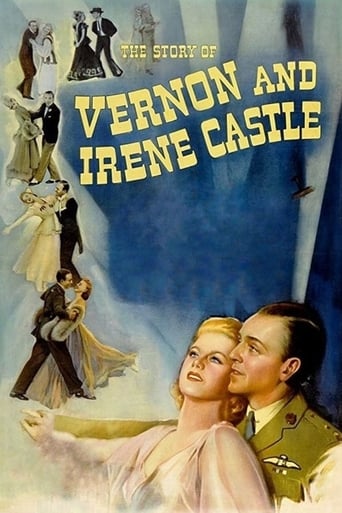
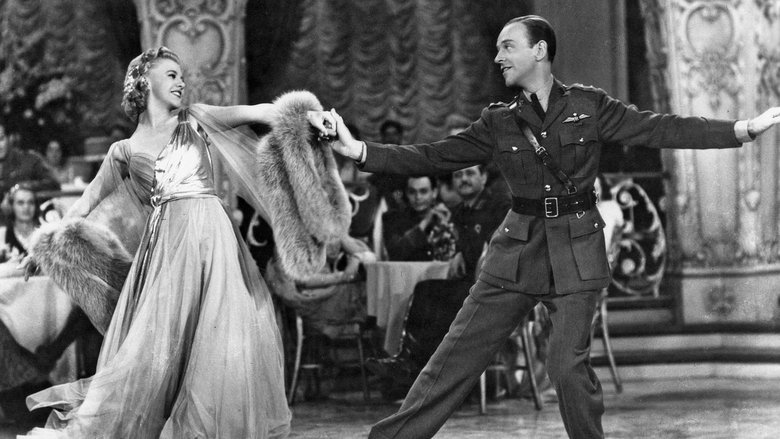
The Story of Vernon and Irene Castle (1939)
In 1911, minor stage comic, Vernon Castle meets the stage-struck Irene Foote. A few misadventures later, they marry and then abandon comedy to attempt a dancing career together. While they're performing in Paris, an agent sees them rehearse and starts them on their brilliant career as the world's foremost ballroom dancers. However, at the height of their fame, World War I begins.
Watch Trailer
Cast


Similar titles
Reviews
While this may be more famous for being Fred and Ginger's last RKO movie (and the real Irene Castle watching every move Ginger made while on the set), "The Story of Vernon and Irene Castle" is a decent musical biography that doesn't depend on songs (there are only a few) but the love story of the most famous dance couple prior to the one that portrayed them here. In the early 20th Century, vaudeville reigned, and comic Vernon Castle didn't have a future until he added Irene to his act and became a dancer instead. They become the toast of Broadway and the world, having influences in practically every segment of culture-fashion, dance steps, and even cigars! But there is a sudden nasty interruption, namely the first World War, and the two lovers are separated.If not the best of their 10 movies (which includes "The Barkley's of Broadway", made 10 years later at MGM), this is one of the most romantic, and the least to focus on wisecracks by Ginger and his efforts to give her class. Fred and Ginger seem to be playing no one other than Fred and Ginger, but that isn't important. They do all of the famous steps that their predecessors do, and in a fantastic montage (where they dance across a map of the United States), the viewer gets to see most of them. The musical highlight is "Too Much Mustard", a bouncy tune set in a nightclub that sets them up for success. Wonderful comic moments are provided by Edna May Oliver and Walter Brennan. "Too Much Mustard" wasn't forgotten with this movie; A rather obscure Liza Minnelli film called "Lucky Lady" would pick it up 35 years later for its opening credits music.
This today seems to be Fred Astaire and Ginger Rogers least known film together as a team. That's a real shame, as this film is lovely, very watchable and great showcase for their fancy footwork. Who better to portray famed ballroom dancers of the 1910's Vernon and Irene Castle than the most brilliant dancing team of 1930's, and possibly all time? RKO certainly knew what they were doing. Maybe the real life of the Castles was not as wholesome as seen here, but I especially enjoyed this film because Ginger and Fred are married virtually the whole way through. No funny, but silly, mistaken identity plots, no Fred chasing Ginger-- while Top Hat and Swing Time are immeasurably better films, it's nice to see a change in plot and style with this one. It's also the most downbeat of all their musicals, as the Castle's real-life story ended in tragedy. But, oh we have the dancing!
For their last film at RKO, Fred Astaire and Ginger Rogers co-starred in The Story of Vernon and Irene Castle. It was the only time the team ever played real people. It was also the only time that no original score was written for them in a film. And of course it was the only screen death for either of them in their team history.Vernon Castle and the former Irene Foote met and wed before the beginning of World War I in what we call the Ragtime era. As an act they popularized ballroom dancing and influenced many other performers including a man who was doing his own act in vaudeville at the time with his sister. That of course being Fred Astaire with his sister Adele. I'm sure doing this film must have in and of itself been a labor of love for the dancing master.In addition Irene Castle set style for women's clothes and hair. When she cut her hair and put in a short bob, women everywhere copied her and the style really took off in the Twenties. With the arrival of World War I, Vernon Castle enlisted and managed to survive the war only to get killed in a training accident after Armistice Day in the USA. Irene kept her career going, appearing in many silent films and she married three more times. She survived her husband by about forty years.The film gave Ginger Rogers her first really dramatic role. The following year Ginger would get the ultimate accolade from her peers with a Best Actress Oscar for Kitty Foyle. I've a feeling that it was on the strength of this film that she got cast in Kitty Foyle.The Story of Vernon and Irene Castle boasts two strong supporting performances by Walter Brennan and Edna May Oliver. In real life, the part that Brennan has as a family retainer for the Foote family was black. But given how blacks were portrayed back in the day, it's probably just as well a black actor didn't play the part.This was a good film for Astaire and Rogers to finish their association with RKO studios. They would team up again in The Barkleys of Broadway ten years later for MGM, but that's a whole other story.
Do people watch Astaire and Rogers films for more than the pleasure of their dancing and singing? Both performed the dialog parts in their musical comedies well too, but most people think of their movies as a series of opportunities to see great dance numbers and to hear music by Gershwin, Kern, Berlin, Porter, or Youmans. I doubt if they recall the plots."Flying Down To Rio" deals with a traveling orchestra that assists in advertising a hotel in Rio De Janairo. Nobody recalls that, but they recall Youmans' melody "Orchids in the Moonlight" and his dance (for Astaire and Rogers) "The Carioca". They also remember the big production number of the young women on the airplane wing ("Ah, Rio, Rio by the Sea - Oh!"). Except for that, few recall the hero is Gene Raymond and the heroine is Delores Del Rio. The running gag of the three agents of the bank that is trying to sabotage the new hotel (and who are only seen as top hatted shadows) may be recalled - but it isn't really worth recalling.In the later musicals the same problems exist. The story of "Gay Divorcée" (originally "Gay Divorce" on Broadway) is how Rogers hires Eric Rhodes to be found with her at a resort hotel so her husband can have grounds for divorce. The Porter score including "Night and Day" and "The Continental" was good - but who recalls the plot (though Rhodes is very funny as the perpetual hired "other man" for instant divorces. The final irony of the plot (almost like a flat joke's punch line) is that Eric Blore knows a nasty secret about the husband, who (for his own reasons) does not want a divorce.The series did try to tie the couple down to more than frivolous plots dealing with mistaken identities or fake personalities. FOLLOW THE FLEET and CAREFREE tried to have plots dealing with sailors putting on a show and with a psychologist falling in love with a patient who was engaged to his best friend (Ralph Bellamy, of course). Both were amusing, but rather slapdash. CAREFREE had a curious concluding moment, when a hypnotized Rogers is literally slapped out of her state of hypnosis. Rogers looks like she has been the victim of domestic violence as she is married.By 1939 Astaire and Rogers were tired of the series, and wanted to go their separate ways. The public was also getting tired of the series. So finally they were given a property that reversed the formula. Instead of the music and dancing ornamenting a bare plot, the plot incorporated the music and dance by telling the story of the greatest ballroom dance team of the first half of the 20th Century, Vernon and Irene Castle.I have often felt that had Vernon Castle lived beyond 1917 into the period of talkie movies, and stayed married to Irene, they might have been in some of the Astaire Rogers films (the choreography of two rival couples dancing would have been fascinating). Vernon might have played a mentor or rival or father to Fred. But it wasn't to be. As the film shows Vernon (who was English-born) enlisted in the Air Corps in 1917, and was killed in a freak accident saving the life of a pilot he was training (the scene in the film is quite savage in showing the crash).In the four years (1913 - 1917) when they swept the world with their mastery of dancing, Vernon and Irene Castle became leading celebrities. The film follows the slow steps to fame they took, including getting stuck for awhile in Paris because Vernon was hired only to be a comic actor, not to be a dancer. It shows how Edna Mae Oliver (as their agent and friend) gets them the breaks they deserve, and how they end as figures of social change (ballroom dancing regained popularity, and they did create not only fashions for men and women but also "the Castle Walk" dance step). That this all happened in four years suggests what their impact would have been if they lived into the 1940s together (Irene Castle died in the 1960s).There are some delightful moments in the film: Ginger Rogers auditioning for her date Fred Astaire by doing "Yama Yama Man" complete with a costume in her parlor. She is imitating the originator of the song, Bessie McCoy. Walter Brennan trying to protect Rogers from Astaire (whose intentions he constantly suspects). Watch him in a small scene watering the grass of the lawn, and ignoring Astaire's questions. Oliver noticing the rhythmic swaying of the overhead lamp in her apartment due to the dancing going on upstairs (where Fred and Ginger are dancing). But what is best is the feeling of impending doom over the couple. We know Vernon is going to die so that means their success and their life together will end soon.This sense of doom makes "The Story of Vernon and Irene Castle" unique among the Astaire - Rogers films - it is a downer. There is no getting away from the loss of happiness Irene Castle suffered, nor the loss of talent the theater and dance world suffered. The concluding moment of the film always haunted me - Irene and Vernon dancing in spirit together, twirling in a never-ending, eventually disappearing embrace. When I saw the film the first time, Irene Castle was still alive. The second time she was gone but the two stars were still living. Now Fred and Ginger are gone too. That final ghostly dance manages to encompass two sets of dance legends, and increases the sadness that surrounds this - to me - best of their films.




